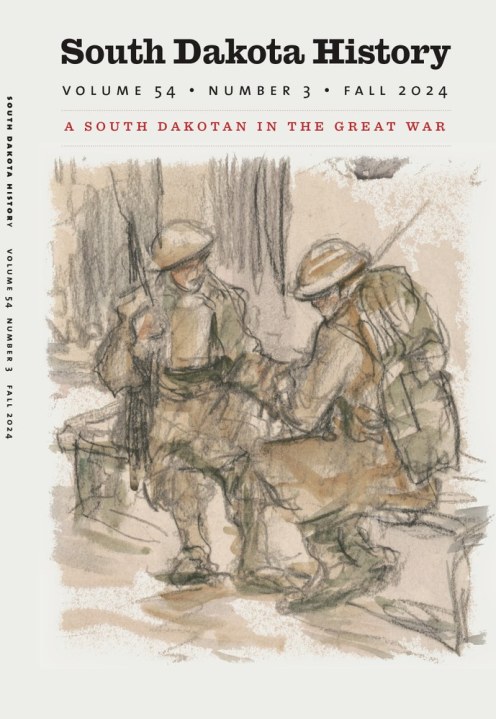SIOUX FALLS, S.D. (KELO) — When she learned about World War I veteran Alfred Dahlin, Corey Christianson knew she had to write his story.
Dahlin, of Sisseton, served with the 362nd Infantry Regiment, 91st Infantry Division and was wounded in France. He returned to Sisseton and worked in a family farm until his death in 1951.
Christianson, a registrar with the South Dakota Historical Society Foundation, wrote Dahlin’s story for the latest edition of South Dakota History, published by the South Dakota Historical Society Press. The article is called “A South Dakotan in the Great War.”
“I really want to write this… I’m really interested in this,” Christianson said.
Dahlin’s family had preserved items from Dahlin’s military service and life and turned those over to the state historical society. Those items included his military uniform, letters he wrote to family members while he was in military service, photos, maps and a diary Dahlin started keeping when he was 14 or 15.
The collection is extensive in large part because of the family’s love for Dahlin and because there are family members with an interest in history.
“The devotion they have to Fred. That family adores Fred,” Christianson said. She worked with three family members, Curt Dahlin, Cal Christensen and Cody Stanley who shared stories and personal items of Dahlin’s.
“I’m not sure how this trait came about, but my family seemed to have an innate sense of what should be kept for the future. I base this on (great-grandmother Kate’s) scrapbooks that have multiple articles on family,” Christensen said in an email to KELOLAND News.
Christianson was told, “Our families are so excited you are writing about him.”
Besides the love Dahlin shared with his family, Christianson said Dahlin’s attitude also impressed her.
“He was a hard-working individual. In the diary, he never complained. There was never any entries about my body’s hurt. I’m tired,” Christianson said. The lack of complaining seems unusual for a teenage boy working on the farm.
Christianson followed Dahlin’s journey from when he was drafted in May 1918, through his time in France until his discharge in 1919 and his return to life in Sisseton until 1951.
In Dahlin’s letters to his family, he describes the landscape of France.
“We are marching through areas already hit by war. It’s blown up. Parts have just exploded,” Christianson said of what Dahlin wrote.
Dahlin was wounded by shrapnel in his left arm. Christianson said, based on Census Bureau records, the arm may not have fully recovered as Dahlin listed working 40 hours a week on the farm as compared to siblings who worked 75 or 80.
But Dahlin was still respected and loved by his family. Christianson’s stories described what she said was “the fun uncle.”
But Dahlin was also reserved and shy at times, according to his mom’s description, Christensen said. He was also kind and gentle, Christensen said.
The family also wanted to make sure Christianson told the “whole story” of Dahlin. Dahlin took his own life in 1951.
In respect of Dahlin’s life, Christianson included a reference to a suicide hotline, “especially because the average number is 22 veterans take their lives a day,” she said.
Christensen said that Dahlin never really talked about the war around his mother but she “recounted that Kate had said multiple times that he (Fred) was never the same when he returned.”
“His story is just not just about his suicide, it’s not just about his death, it’s about his service and his life and the love his family has, and I think that’s what comes across in the article,” Christianson said.
“I think Corey did a fantastic job pulling together all of the information as well as researching the different avenues that supported the documentation we supplied,” Christensen said in his email.
Christianson’s article on Dahlin is an addition to the items shared by the family.
The uniform and related items are on the shortlist to be on display when the state historical society’s museum project is completed, she said. Dahlin’s photos, letters, and other items will be included in the society’s archives.
It’s unusual to have such an extensive collection from a World War I soldier, Christianson said. She has a background in military history and said it’s more likely to have material from World War II.
“When we got the uniform my biggest freak out is over the boots. World War I boots are really rare to find intact,” Christianson said.
The museum, archives and the historical society press cooperated to share Dahlin’s story and the collection.
Christianson said it’s exciting to think that the public, even a hundred years from now, can learn more about World War I and Dahlin because of their work and the generosity of Dahlin’s family.
“This is one of the reasons we donated our artifacts to the SDHS. We wanted to ensure that they were well cared for so that all generations could study them,” Christensen said in an email.
To learn more about Dahlin, you can buy the latest South Dakota History through this link. Christianson will also be featured on the Nov. 12 History Talk with more information in this link.
Christianson said she is reaching out to veterans groups and similar about Dahlin’s story.


